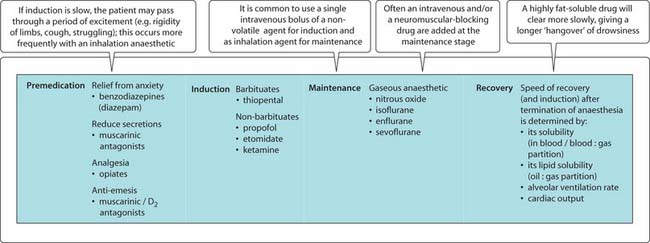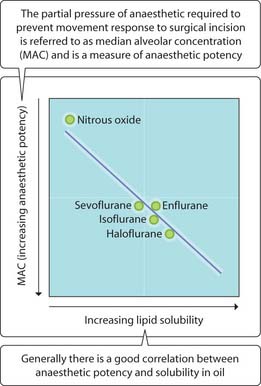39 General anaesthetics
General anaesthesia is the loss of awareness of sensory inputs resulting in analgesia, unconsciousness (sedation and hypnosis), amnesia and immobilization. The loss of consciousness and amnesia is a consequence of suppression of neuronal excitability in various brain regions (e.g. midbrain reticular formation, thalamus) while loss of mobility results from depression of spinal neurons. Neuronal conduction is not sensitive to general anaesthetic agents, and the peripheral axons of motor neurons distal to the spinal cord do not contribute to immobility nor do these drugs directly inhibit neuromuscular transmission. The higher centres of the brain are more susceptible to general anaesthetics and as a consequence sedation, hypnosis and amnesia can be achieved at much lower concentrations than that required to prevent movement in response to a surgical incision and the autonomic response to pain. General anaesthesia is achieved with a combination of i.v. and inhalational drugs. Other agents may also be administered as premedication (Fig. 3.39.1).
Volatile anaesthetics
Volatile general anaesthetics include the halogenated hydrocarbons (halothane), halogenated ethers (sevoflurane, desflurane, enflurane, isofluorane) and non-carbon-based gases (nitrous oxide). While the potency of inhalational anaesthetics cor-relates with lipid solubility (Meyer–Overton rule, Fig. 3.39.2), exceptions to this rule shifted attention from membrane lipids to proteins, and it is now recognized that binding to proteins in neuronal membranes alters their gating kinetics. Volatile anaesthetics enhance the activity of GABAA and glycine receptors, thereby facilitating hyperpolarization and reducing neuronal excitability. Volatile anaesthetics can also inhibit the function of receptors (e.g. NMDA, nicotinic) that increase postsynaptic channel activity (Fig. 3.39.3).
< div class='tao-gold-member'>
Stay updated, free articles. Join our Telegram channel

Full access? Get Clinical Tree






